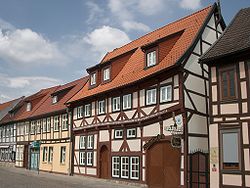Salzwedel
| Salzwedel | |||
|---|---|---|---|

Typical old housing in Salzwedel
|
|||
|
|||
| Coordinates: 52°51′N 11°09′E / 52.850°N 11.150°ECoordinates: 52°51′N 11°09′E / 52.850°N 11.150°E | |||
| Country | Germany | ||
| State | Saxony-Anhalt | ||
| District | Altmarkkreis Salzwedel | ||
| Government | |||
| • Mayor | Sabine Blümel | ||
| Area | |||
| • Total | 304.53 km2 (117.58 sq mi) | ||
| Population (2015-12-31) | |||
| • Total | 24,410 | ||
| • Density | 80/km2 (210/sq mi) | ||
| Time zone | CET/CEST (UTC+1/+2) | ||
| Postal codes | 29410, 29413, 29416 | ||
| Dialling codes | 03901, 039032, 039033, 039037, 039038 | ||
| Vehicle registration | SAW | ||
| Website | www.salzwedel.de | ||
Salzwedel (German pronunciation: [ˈzaltsveːdəl], officially known as Hansestadt Salzwedel, is a town in Saxony-Anhalt, Germany. It is the capital of the district (Kreis) of Altmarkkreis Salzwedel, and has a population of approximately 21,500. Salzwedel is located on the German Timber-Frame Road.
Salzwedel is situated at the Jeetze River in the northwestern part of the Altmark. It is located between Hamburg and Magdeburg. Distances from Uelzen are 44 km (27 mi) E, 12 km (7 mi) S of Lüchow, 41 km (25 mi) N of Gardelegen and 24 km (15 mi) W of Arendsee. In 1968 test drillings reveal a significant reservoir of natural gas near the city.
The castle of Salzwedel in the Altmark was first documented in 1112. As part of the Margraviate of Brandenburg, the settlement was first mentioned as a town in 1233. To the northeast of the old town (Altstadt), a new town (Neustadt) began development in 1247. In the Middle Ages Salzwedel belonged to the Hanseatic League from 1263 to 1518. As to religion Salzwedel belonged to the Diocese of Verden (till 1648).
The city from 1247 began developing as a reestablishment from the old part of the town. In 1701 it became part of the Kingdom of Prussia. In 1713, the two towns Altstadt and Neustadt became one. Salzwedel became part of the Prussian Province of Saxony in 1815 after the Napoleonic Wars. In 1870 it received a railroad connection. The medieval part of the town remains the commercial and administrative center of the town until today.
...
Wikipedia




